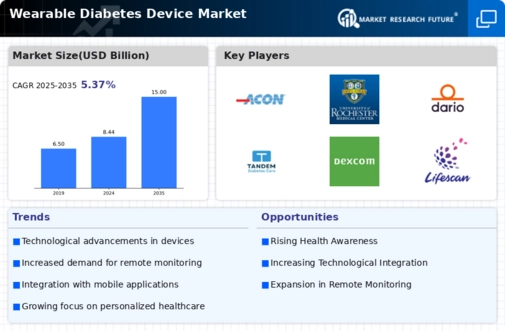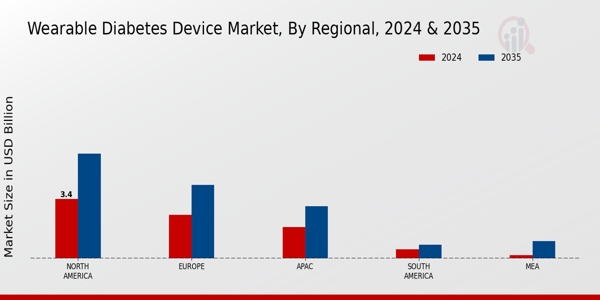Growing Health Awareness
An increase in health awareness among the global population is propelling the Global Wearable Diabetes Device Market Industry. Individuals are becoming more proactive in managing their health, leading to a higher demand for wearable diabetes devices that provide real-time monitoring and data analytics. Educational campaigns and initiatives by health organizations are further promoting the importance of diabetes management, encouraging individuals to adopt these technologies. This shift in consumer behavior is expected to contribute to the market's growth, as more people seek to leverage wearable devices for better health outcomes.
Technological Advancements
Technological advancements in wearable devices significantly influence the Global Wearable Diabetes Device Market Industry. Innovations such as continuous glucose monitoring systems, which provide real-time data and alerts, enhance patient engagement and adherence to treatment regimens. The integration of artificial intelligence and machine learning algorithms into these devices allows for personalized insights and predictive analytics, improving overall diabetes management. As technology continues to evolve, it is anticipated that the market will experience a compound annual growth rate of 5.37% from 2025 to 2035, driven by the demand for more sophisticated and user-friendly devices.
Rising Prevalence of Diabetes
The increasing prevalence of diabetes globally serves as a primary driver for the Global Wearable Diabetes Device Market Industry. According to health statistics, the number of individuals diagnosed with diabetes continues to rise, with projections indicating that by 2035, approximately 700 million people will be affected. This surge in diabetes cases necessitates innovative management solutions, including wearable devices that facilitate real-time monitoring of glucose levels. As a result, the market is expected to grow from 8.44 USD Billion in 2024 to 15 USD Billion by 2035, reflecting a growing demand for effective diabetes management tools.
Supportive Government Initiatives
Supportive government initiatives aimed at combating diabetes are fostering growth in the Global Wearable Diabetes Device Market Industry. Many governments are implementing policies that promote the use of technology in healthcare, including subsidies for diabetes management devices and funding for research and development. These initiatives not only enhance accessibility to wearable diabetes devices but also encourage innovation within the industry. As governments recognize the economic burden of diabetes, investments in wearable technology are likely to increase, further driving market expansion.
Rising Demand for Remote Patient Monitoring
The rising demand for remote patient monitoring solutions is a significant factor influencing the Global Wearable Diabetes Device Market Industry. With an increasing emphasis on telehealth and remote healthcare services, wearable diabetes devices are becoming essential tools for managing diabetes from home. These devices enable healthcare providers to monitor patients' glucose levels and overall health remotely, ensuring timely interventions when necessary. This trend is expected to accelerate market growth, as more patients and healthcare systems adopt remote monitoring solutions to enhance diabetes management.



















